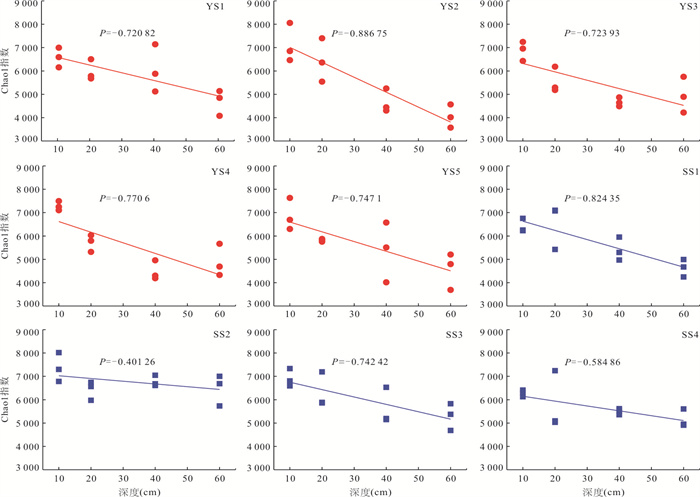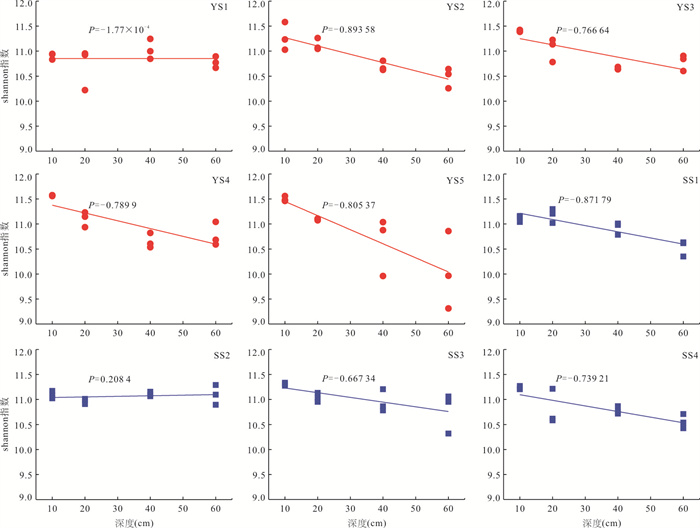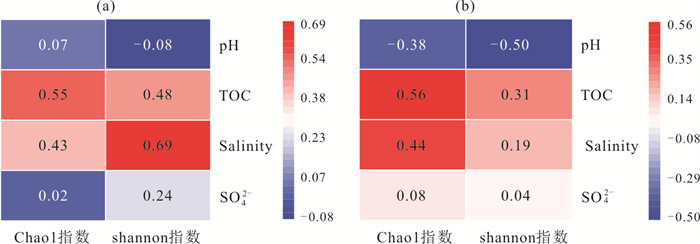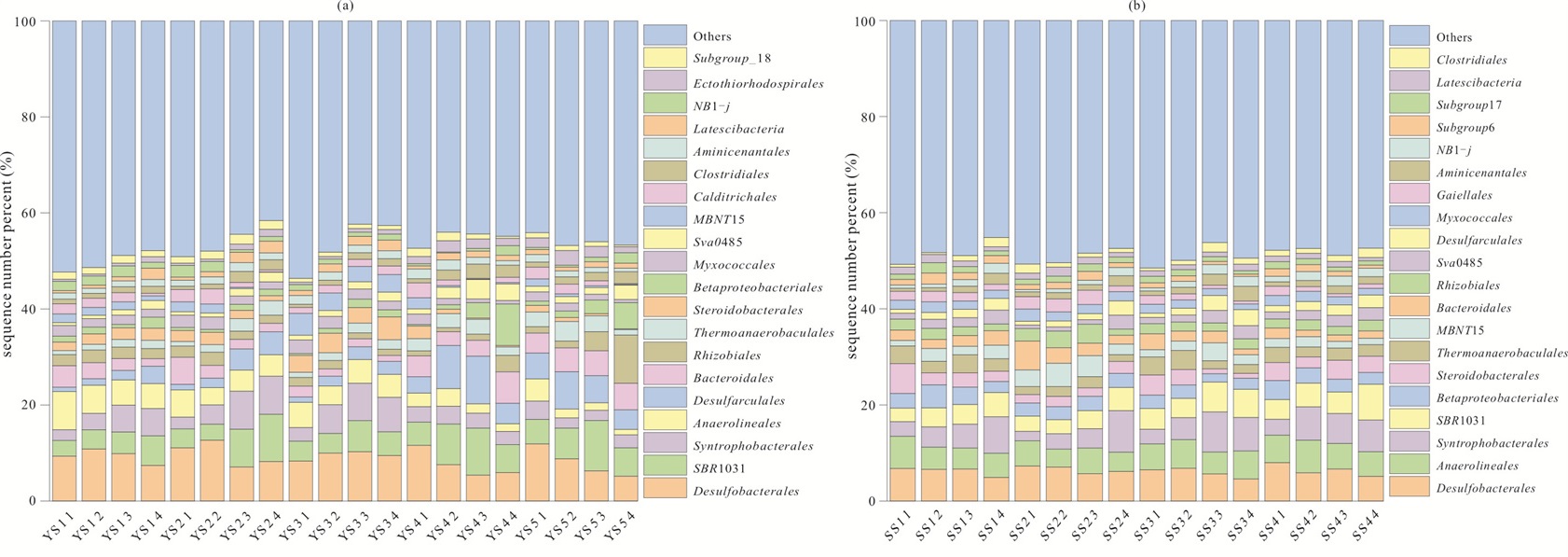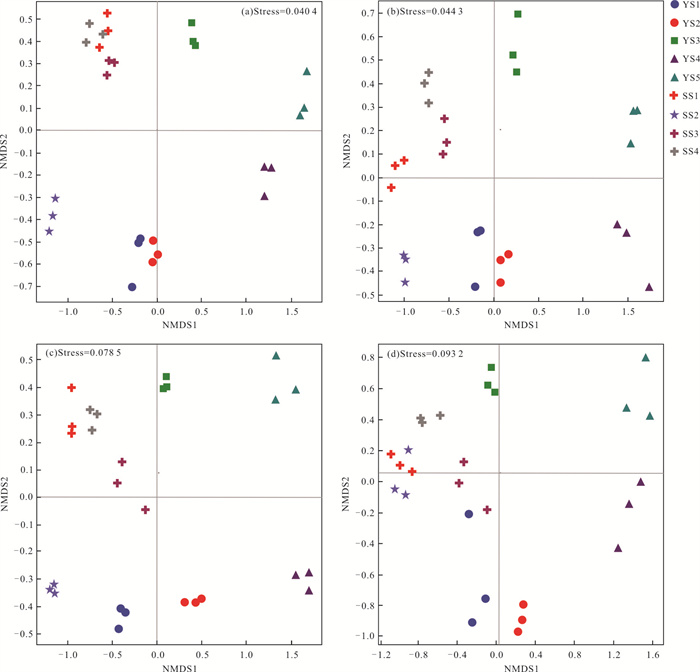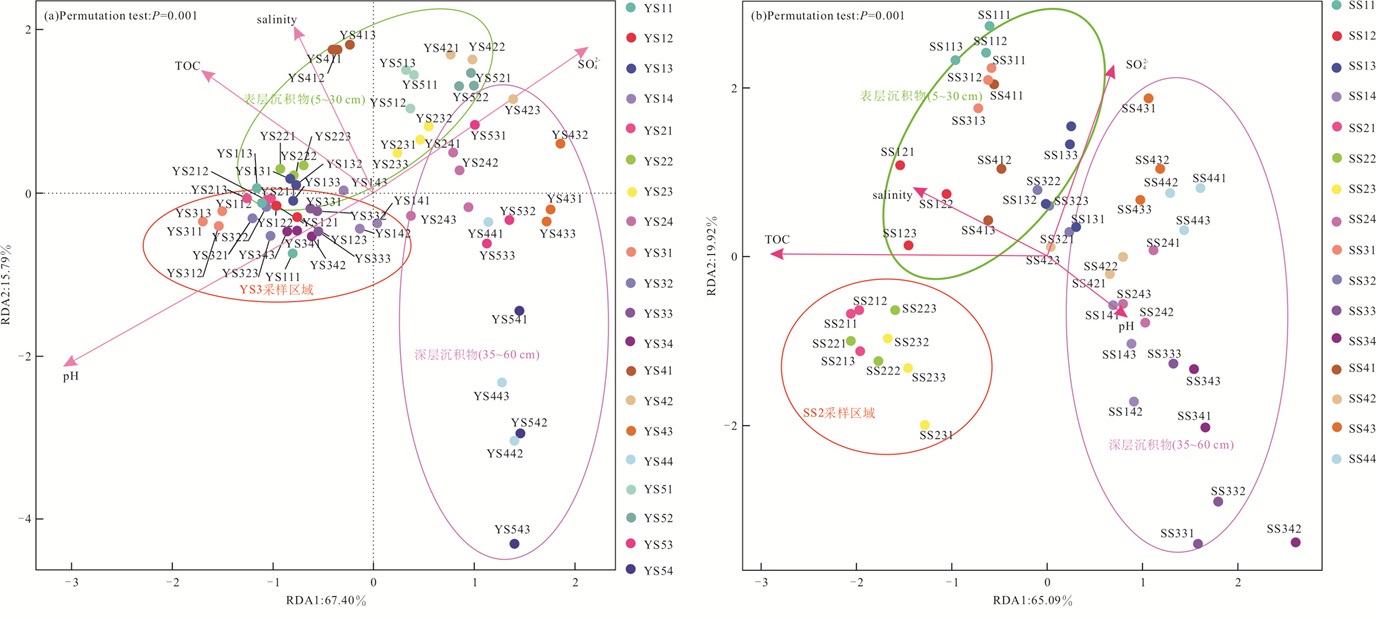Microbial Community Structure and Its Response to Environment in Mangrove Sediments of Dongzhai Port
-
摘要:
在红树林覆盖区域和光滩沉积物中存在着丰富的微生物群落,这些微生物在驱动红树林湿地的生物地球化学过程中起着至关重要的作用.深入了解东寨港红树林湿地沉积物中微生物的多样性分布特征,对探究东寨港红树林湿地中的生物地球化学过程和湿地的生态保护具有重要意义.本研究采用Illumina Miseq高通量测序技术,在东寨港的演丰西河和三江河采集108个沉积物样品,分析其地球化学和微生物群落特征,探讨不同环境因子对两岸红树林覆盖区域和光滩微生物群落的影响.结果显示:Proteobacteria是东寨港红树林沉积物中的优势种群,沉积物中微生物丰度和多样性随深度整体上呈减小趋势;演丰西河和三江河沉积物中微生物群落结构存在显著差异;pH是控制光滩区域沉积物中微生物群落结构的主要环境因子,而盐度是控制红树林表层沉积物中微生物群落结构的环境因子.上述研究结果表明:东寨港红树林沉积物中微生物分布特征和群落结构受到了人类活动的影响,微生物丰度和多样性随深度整体呈减小的变化趋势,不同采样区域沉积物中微生物群落结构存在明显差异,该差异是自然因素(盐度和pH)和人为因素(水产养殖)双重作用的结果.
Abstract:There are abundant microbial communities in mangrove cover and plain sediments. These microorganisms play a vital role in driving the biogeochemical process of mangrove wetlands. It is of great significance to understand the diversity and distribution characteristics of microorganisms in the Dongzhai port mangrove wetland sediments for exploring the biogeochemical process and ecological protection of the wetland. In this study, we collected 108 sediment samples from Yanfengxi River and Sanjiang River in Dongzhai port, and Illumina Miseq high-throughput sequencing technology was used to analyze their geochemical and microbial community characteristics, and the effects of different environmental factors on microbial communities were also discussed. The results show that Proteobacteria is the dominant bacteria species in the mangrove sediments of Dongzhai port, and the microbial abundance and diversity in the sediments generally decrease with depth. There are significant differences in microbial community structure between Yanfengxi River and Sanjiang River. pH is the main environmental factor controlling the microbial community structure in the sediments of plain area, while salinity is controlling the microbial community structure in the surface sediments of mangroves. The above research results show that microorganism distribution and community structure inDongzhai port mangrove sediments are influenced by human activities, and microbial abundance and diversity of the change trend of decrease with depth as a whole. There exist obvious differences in microbial community structure from different sediment sampling areas, as a result of the dual function of natural factors (such as salinity, pH) and human factors (aquaculture).
-
Key words:
- Dongzhai port /
- microorganism /
- community structure /
- environmental factor /
- environmental geology
-
0. 引言
红树林是陆地和海洋之间过渡的沿海生态系统,在热带和亚热带环境中发挥着重要的生态保护作用(Alzubaidy et al.,2016;Cabral et al.,2018).由于人类活动的影响,红树林湿地面临面积锐减、生态系统结构简化、生物多样性降低、生态功能退化等问题(黄初龙和郑伟民,2004).红树林的退化将导致海岸生物多样性的丧失,危及海岸城市经济社会的可持续发展(Polidoro et al.,2011).红树林生长区域长期遭受海水的周期性浸淹,其土壤呈现出强还原性、强酸性和高盐度等特点,这种独特的生长环境决定了其根系沉积物中微生物的多样性和珍稀性(Holguin et al.,2001).研究表明,在红树林生态系统中,真菌和细菌占所有微生物总量的91%,其中细菌总量远高于真菌(Alongi et al.,1998).微生物作为红树林生态系统的重要组成部分,通过参与红树林生态系统中的物质循环和能量流动,(如C、N、P、S等营养物质的循环),对红树林生态系统化学环境的形成起着重要的作用(Thatoi et al.,2013).
东寨港红树林湿地是我国面积最大、生态系统结构最完整和生物多样性最为丰富的红树林湿地,微生物群落结构复杂,生态系统比较稳定,不同植被下微生物多样性和群落结构存在显著差异(姚琦等,2017).但是,近年来受鱼类养殖和毁林伐木等人为活动的影响,东寨港红树林湿地环境遭到了污染与破坏,生态结构简化,生态功能衰减(黎明等,2004).生态环境的变化会直接或间接地影响微生物群落结构的多样性,进而对整个生态系统产生影响.
本研究选择东寨港4条主要河流中的演丰西河和三江河两岸红树林沉积物中的微生物为研究对象,采集不同区域和不同深度的沉积物样品,基于高通量测序技术重点分析了东寨港红树林湿地沉积物中微生物多样性、差异性以及对环境因子的响应,以期阐明东寨港红树林湿地沉积物中微生物的群落结构特征以及微生物对环境变化的响应,为东寨港红树林湿地的生态恢复与保护提供科学依据.
1. 材料和方法
1.1 研究区概况
本研究采样区域位于东寨港红树林湿地,该湿地位于海南岛东北部海口市境内,地理坐标为东经110°32′~110°37′,北纬19°51′~20°01′,演州河、三江河、演丰东河及演丰西河4条主要淡水河流从不同方向汇入港内,是东寨港的主要淡水来源.东寨港红树林湿地主要地貌类型为滨海堆积平原,沉积物主要成分为全新统滨海相堆积层的细沙和粉细砂,地层主要为新生代玄武岩和三叠系花岗岩,局部分布白垩系砂砾岩,地表多被玄武岩风化残积的粉质黏土覆盖,下伏玄武岩,裂隙孔洞不发育.演丰西河和三江河分别位于港口和港尾区域,地理位置接近,其沉积物岩性特征不存在明显差异.
1.2 样品采集与保存
潮汐作用和人类扰动是造成湿地沉积物中微生物存在差异的主要原因,本研究选择人为扰动较小、潮汐扰动较大的演丰西河和人为扰动较大、潮汐扰动较小的三江河,采集演丰西河和三江河两岸的红树林覆盖区域和光滩沉积物样品.在演丰西河设置5个采样区域,其中YS1、YS2、YS4和YS5为红树林覆盖区域,且YS1和YS2位于演丰西河河内区域,YS4和YS5位于演丰西河河口区域,YS3为靠近YS4的光滩区域.在三江河设置4个采样区域,SS1、SS2、SS3和SS4均为红树林覆盖区域,SS1~SS4位置依次从三江河河内到河口.考虑到最表层沉积物中的微生物信息很难反映沉积物中微生物群落结构的真实情况,本研究各个采样区设置的4个采样深度分别为5~10 cm、15~20 cm、35~40 cm和55~60 cm,YS11表示演丰西河YS1采样区域5~10 cm深度采样点,共计设置36个采样点,具体采样区域如图 1所示.
用酒精消毒后外径为110 mm的PVC管采取深度为60 cm的柱状沉积物,分别从柱状沉积物的5~10 cm、15~20 cm、35~40 cm和55~60 cm区域取3份10 g左右沉积物样品装入无菌采样袋,并保存于-20 ℃环境中待测,另外将相同区域剩余的沉积物样品装入自封袋于0 ℃环境中保存待测.
1.3 理化指标的测定
本研究选择对红树林沉积物中微生物群落结构影响较大的pH、盐度、TOC和SO42-四项理化指标进行测定,研究沉积物微生物群落结构对环境因子的响应(欧益希等,2016;肖玉娜等,2020;谌佳伟等,2020).沉积物pH和可溶性盐分均在中国地质大学(武汉)环境学院实验室采用电位法完成测定,具体测试步骤分别参考《NY/T1377⁃2007》和《LY/T1251⁃1999》;沉积物中的TOC在中国科学院武汉植物园采用TOC分析仪(型号:Vario TOC)完成测定,沉积物中可溶态SO42-浓度在中国地质大学(武汉)环境学院实验室采用离子色谱(型号:Thermo Fisher,ICS⁃1100;Dionex,ICS⁃1100)完成测定,水土质量比为1∶4.
1.4 高通量测序分析
1.4.1 DNA提取和PCR扩增
使用DNA试剂盒(Omega Mag⁃bind soil DNA kit(M5635⁃02))从0.5 g沉积物中提取DNA,同时采用Nanodrop对DNA进行定量,并通过1.2%琼脂糖凝胶电泳检测DNA提取质量.根据序列中的保守区域,采用细菌通用引物338F:5′⁃ACTCCTACGGGAGGCAGCA⁃3′和806R:5′⁃GGACTACH VGGGTW TCTAAT⁃3′扩增沉积物样品细菌16SrDNA的V3⁃V4可变区.
1.4.2 测序文库制备和高通量测序
上机测序前,首先采用Illumina公司的TruSeq Nano DNA LT Library Prep Kit构建测序文库,并对文库在Agilent Bioanalyzer上进行质检,然后采用Quant⁃iT PicoGreen dsDNA Assay Kit在Promega QuantiFluor荧光定量系统对文库进行定量,对合格的文库,在MiSeq机器上利用MiSeq Reagent Kit V3(600cycles)进行2×300bp的双端测序.
1.5 数据分析
利用Chao1和Shannon等α多样性指数对微生物结构进行分析,通过Pearson分析沉积物中微生物丰度、多样性和环境因子的相关性.为了分析不同采样区域和不同深度沉积物中微生物群落结构的相似性和差异性,在Bray⁃Curtis距离下通过NMDS对多维的数据进行降维分析.为了研究环境参数与细菌群落结构之间的关系,使用R语言的vegan包进行冗余分析(RDA).
2. 结果与分析
2.1 研究区沉积物理化性质
演丰西河和三江河沉积物的理化性质如表 1所示.演丰西河红树林覆盖区域沉积物pH为3.39~6.03,光滩区域不同深度沉积物pH为6.55~6.81,三江河红树林覆盖区域沉积物pH为5.19~5.90,东寨港红树林湿地沉积物总体偏酸性,演丰西河红树林覆盖区域沉积物pH波动幅度明显高于三江河,光滩区域沉积物pH值明显高于红树林覆盖区域.演丰西河红树林覆盖区域沉积物盐度为4.52~ 8.00 mS/cm,光滩区域不同深度沉积物盐度为5.70~8.15 mS/cm,三江河红树林覆盖区域沉积物盐度为2.56~5.69 mS/cm,三江河沉积物的盐度则整体低于演丰西河沉积物,红树林覆盖区域沉积物和光滩沉积物盐度并没有表现出明显的区别,研究表明红树林沉积物盐度的变化随着地点、生境、潮汐等因素的不同存在很大的差异(Alvarenga et al.,2015).演丰西河红树林覆盖区域沉积物TOC为0.21%~1.58%,光滩区域不同深度沉积物TOC在0.77%~1.20%,三江河红树林覆盖区域沉积物TOC为0.43%~1.78%,三江河红树林覆盖区域沉积物TOC总体高于演丰西河,沉积物中TOC含量垂直分布和水平分布的空间变异较大,并且受特殊地形和水产养殖的影响,东寨港红树林沉积物中TOC含量处于我国红树林沉积物TOC含量的中上水平(李燕等,2018).演丰西河红树林覆盖区域沉积物SO42-为327.8~1 089 mg/kg,光滩区域不同深度沉积物SO42-浓度在327.8~487.3 mg/kg,三江河红树林覆盖区域沉积物SO42-浓度为246.4~594.6 mg/kg,演丰西河河口位置红树林覆盖区域SO42-浓度明显高于河内,三江河4个采样区域不同深度沉积物中SO42-浓度变化较小.
表 1 演丰西河和三江河红树林不同深度沉积物样品的理化性质Table Supplementary Table Physical and chemical properties of sediment samples from the mangroves of Yanfengxi River and Sanjiang River at different depths深度(cm) 理化性质 YS1 YS2 YS3 YS4 YS5 SS1 SS2 SS3 SS4 10 pH 5.99 6.03 6.63 4.03 4.11 5.63 5.61 5.47 5.58 20 5.97 5.84 6.73 3.39 3.54 5.19 5.73 5.69 5.9 40 5.66 4.61 6.55 3.67 3.83 5.4 5.65 6.09 5.63 60 5.52 4.15 6.81 5.46 5.89 5.66 5.07 5.89 5.97 10 盐度(mS/cm) 6.54 6.34 8.15 8.00 6.62 5.32 5.35 5.07 4.52 20 6.25 6.83 7.00 7.27 7.38 4.70 5.60 3.72 5.62 40 6.65 7.71 5.70 6.42 6.41 3.66 5.49 3.13 5.19 60 6.50 6.86 6.55 6.05 4.52 3.60 5.40 2.56 5.69 10 TOC(%) 1.583 1.192 0.772 1.681 0.825 1.303 1.777 1.211 0.765 20 1.544 1.530 0.847 1.130 1.469 1.500 1.591 0.841 1.014 40 1.336 0.916 0.855 0.388 0.849 1.190 1.287 0.762 1.085 60 1.185 0.978 1.201 0.493 0.205 1.053 1.332 0.431 1.055 10 SO42-(mg/kg) 392.5 400.6 333.9 964.1 930.5 594.6 364.4 481.5 370.9 20 361.1 372.1 327.8 886.5 1089 483.8 368.1 394.0 316.1 40 479.4 578.0 432.0 502.6 824.9 345.1 322.5 278.1 548.7 60 555.1 850.0 487.2 718.2 402.1 357.6 568.7 246.4 623.2 2.2 研究区沉积物微生物多样性
本研究在演丰西河沉积物样品中共获得6 763 655条有效序列,在三江河沉积物样品中共获得6 192 434条有效序列.为了较为全面地评估东寨港红树林沉积物中微生物群落的多样性,以Chao1指数表征东寨港红树林沉积物中微生物的丰度,以Shannon指数表征东寨港红树林沉积物微生物的多样性.
对沉积物微生物丰度和多样性与采样深度进行相关性分析,探究红树林沉积物中微生物群落垂向变化趋势,结果表明东寨港演丰西河和三江河红树林沉积物中微生物丰度随着深度的增加均减小,演丰西河沉积物中微生物丰度随着深度的变化幅度明显小于三江河(图 2).有研究表明北仑河口红树林0~20 cm沉积物中微生物丰度随深度变化并不明显,可能原因是该研究与本研究设置的采样深度不同,本研究设置的0~60 cm采样深度能够形成相对明显的微生物丰度随深度变化规律(Wu et al.,2016).演丰西河和三江河红树林沉积物中微生物的多样性随着深度变化各不相同,整体上沉积物中微生物多样性随深度增加而减小(图 3).在温带和亚热带森林土壤0~60 cm深度,nifH、AOA和nirS的多样性随深度增加同样呈下降趋势(Tang et al.,2018).沉积物中微生物多样性随深度的增加而减小的主要原因是沉积物的特征存在差异(Taketani et al.,2010;Andreote et al.,2012).演丰西河YS1区域沉积物中微生物多样性随深度基本保持不变,YS2、YS3、YS4和YS5区域沉积物中微生物多样性随深度增加而减小.三江河SS1、SS3和SS4区域沉积物中微生物多样性随深度增加而减小,SS2区域沉积物中微生物多样性随深度增加而增加(图 3).研究显示盐度和海水周期性淹没是影响红树林沉积物中微生物群落多样性的主要原因,有机质(OM)和SO42-浓度是影响红树林沉积物中微生物丰度和多样性的关键地球化学指标(Gonzalez-Acosta et al.,2006;Henriques et al.,2006;Zhu et al.,2018).相关性热图显示,影响东寨港演丰西河和三江河沉积物中微生物丰度和多样性的主要环境因子是盐度和TOC(图 4),且TOC对沉积物中微生物丰度具有明显的影响.演丰西河光滩区域与红树林覆盖区域沉积物中微生物的丰度和多样性随深度的变化不存在明显差异,说明是否被红树林覆盖不影响滨海湿地沉积物中微生物的丰度和多样性垂向变化规律.三江河SS2采样区域沉积物中微生物的丰度和多样性随深度的变化与SS1、SS3和SS4区域表现出明显差异性,SS2区域沉积物中TOC明显高于其他采样区域,且三江河采样区域TOC整体高于演丰西河.红树林沉积物中微生物多样性受自然环境和人为活动双重影响,红树林周边水产养殖排放的废水会造成沉积物中TOC升高,而沉积物中TOC升高会影响红树林沉积物中微生物的多样性(Nathan et al.,2020).
2.3 研究区沉积物微生物群落特征
Proteobacteria是中国、马来西亚、印度和巴西等已调查红树林沉积物中的优势菌种(Mendes et al.,2012;Priya et al.,2018;Zhu et al.,2018;Nathan et al.,2020).Proteobacteria也是东寨港红树林沉积物中的优势菌种,Proteobacteria包含Alphaproteobacteria、Betaproteobacteria、Deltaproteobacteria和Gammaproteobacteria四个纲,Deltaproteobacteria和Gammaproteobacteria在东寨港红树林沉积物样品中均占有较高的丰度,Alphaproteobacteria在三江河具有较高的丰度.大量研究表明,Gammaproteobacteria和Alphaproteobacteria是红树林沉积物中C、N和S循环的主要参与细菌,Deltaproteobacteria主要参与红树林沉积物中铁和硫酸盐还原(Foti et al.,2007;Dias et al.,2010;Hori et al.,2010;Andreote et al.,2012).对海洋环境中的浮游微生物群落开展的研究表明,Alphaproteobacteria偏爱高盐度环境,沙漠土壤中的Alphaproteobacteria同样偏爱高盐度环境(Kirchman et al.,2005;Fortunato and Crump,2015;Zhang et al.,2019).本研究中,Alphaproteobacteria丰度较高的区域恰恰是盐度较低的YS54和三江河红树林沉积物,这说明Alphaproteobacteria在不同环境条件下的耐盐能力可能存在差异(Bai et al.,2020).Dehalococcoidia在演丰西河丰度较高,在三江河丰度较低,Bacteroidia在演丰西河和三江河均具有一定丰度.Bacteroidia在植物氮、磷、蛋白质的代谢,以及纤维素的降解和提高植物抗逆性等方面具有重要作用(杨盼等,2020).
为了对沉积物中的微生物群落组成进行详细分析,本文将所有的序列分类到目和科水平(如图 5).演丰西河红树林覆盖区的沉积物中,丰度较高的微生物分别是Desulfobacterales(5.19%~12.67%)、SBR1031(3.27%~10.52%)、Desulfarculales(0.89%~9.91%)、Syntrophobacterales(2.11%~7.90%)和Anaerolineales(1.14%~7.96%).演丰西河光滩区域沉积物中,丰度较高的微生物分别是Desulfobacterales(8.31%~10.27%)、Syntrophobacterales(2.84%~7.78%)、SBR1031(4.12%~6.47%)、Anaerolineales(3.92%~5.26%)和Thermoanaerobaculales(3.25%~4.75%).在YS11(4.48%)、YS21(5.63%)、YS41(4.35%)、YS44(6.51%)、YS51(4.16%)、YS52(4.96%)、YS53(5.21%)和YS54(5.53%)采样点的沉积物样品中,Bacteroidales也具有较高丰度.在YS54采样点沉积物样品中,Rhizobiales的丰度达到了10.02%,明显高于演丰西河其他采样点(如图 5a).在三江河所有沉积物采样点中,丰度较高的微生物分别是:Desulfobacterales(4.60%~8.00%)、Anaerolineales(3.73%~6.79%)、Syntrophobacterales(1.97%~8.61%)、SBR1031(2.84%~7.45%)和Betaproteobacteriales(1.75%~4.77%).在点SS11样品中,Steroidobacterales(6.21%)丰度明显高于其他采样点(5b).
Desulfobacterales和Syntrophobacterales在演丰西河和三江河沉积物中均具有较高的丰度,Desulfarculales在演丰西河红树林覆盖区域沉积物中丰度较高,而在演丰西河光滩沉积物和三江河红树林覆盖区域沉积物中丰度较低.Desulfobacterales、Syntrophobacterales和Desulfarculales属于Deltaproteobacteria,主要参与红树林沉积物中硫还原代谢过程(Gomes et al.,2014;Ismail et al.,2017;Zhang et al.,2018).SBR1031和Anaerolineales均属于Chloroflexi的Anaerolineae,在所有区域的沉积物中均有较高的丰度,Anaerolineae可以作为异养降解菌降解碳水化合物、氨基酸和石油相关化合物(Yamada et al.,2005;Sutton et al.,2013).在红树林根际,石油污染土壤和污泥环境中均存在Anaerolineae(Schloss et al.,2009;Sutton et al.,2013;Wu et al.,2016).在柴油污染的土壤中Anaerolineae丰度高于未被污染的土壤,在未受人为影响的红树林湿地中丰度较高的微生物群落为Betaproteobacteria、Deltaproteobacteria、Firmicutes、Actinobacteria和Bacteroidetes(Dias et al.,2010;Sutton et al.,2013).Anaerolineae在本研究的所有样品中丰度均较高,其丰度为10.02%~20.84%,明显高于中国云霄红树林沉积物中Anaerolineae(7.851%)丰度,说明东寨港红树林沉积物受到了一定的人为污染(Lin et al.,2019).另外,前人发现被石油污染的红树林中Deltaproteobacteria丰度会增加,表明红树林生态系统中有机污染物浓度的升高也会造成Deltaproteobacteria丰度增加(Andreote et al.,2012;Liu et al.,2019).这同样反映东寨港红树林湿地沉积物在一定程度上受到了人为污染.Betaproteobacteriales在三江河丰度较高,而在演丰西河沉积物样品中丰度较低.Betaproteobacteriales属于固氮菌,更偏向存在于淡水环境中,三江河比演丰西河更加远离海洋,因此三江河沉积物中盐度低于演丰西河沉积物,说明盐度是影响Betaproteobacteriales丰度的主要环境因子(Behera et al.,2017).
2.4 研究区沉积物微生物群落结构对环境因子的响应
笔者基于Bray⁃Curtis距离算法对演丰西河和三江河沉积物中微生物群落进行NMDS分析,结果表明演丰西河和三江河不同深度沉积物中微生物群落结构均存在明显差异(图 6).研究表明红树林根际沉积物中微生物群落结构会随地理位置的变化而存在明显差异(Colares and Melo,2013;Tong et al.,2019).河口沉积环境中微生物群落结构是由盐度和有机与无机化合物的有效性决定的(Smith and Kemp,2003).演丰西河采样区域靠近海洋,三江河采样区域靠近陆地,演丰西河采样区域受潮汐影响较大,沉积物盐度较高,三江河红树林沉积物盐度较低(表 1),说明盐度是影响演丰西河和三江河红树林区域微生物群落结构差异的环境因子.进一步分析不同深度下的情况(在5~10 cm、15~ 20 cm和35~40 cm),YS1和YS2区域、YS4和YS5区域、以及SS1、SS3和SS4区域同一深度沉积物微生物群落结构具有较高相似性,YS3区域、SS2区域沉积物微生物群落结构与其他区域均存在明显差异(图 6a~6c).在55~60 cm深度,SS1、SS2、SS3和SS4区域、YS1和YS2区域、YS4和YS4区域沉积物中微生物群落结构具有较高的相似性,而YS3区域沉积物微生物群落结构存在明显差异(图 6d).NMDS分析结果表明YS1和YS2区域与YS4和YS5区域不同深度的沉积物微生物群落结构均存在显著的差异,表明空间差异对红树林沉积物中微生物结构也有显著影响(Andreote et al.,2012;Gomes et al.,2014).大量研究表明,在河流不同位置沉积物结构和有机质含量的变化是导致微生物群落结构差异的重要因素(Crump et al.,2004;Dias et al.,2009).YS3区域沉积物样品均单独聚为一类,表明光滩区域沉积物中微生物群落结构与红树林覆盖区域存在显著差异,已有研究也证明红树林覆盖区域和无红树林覆盖区域沉积物中微生物群落结构存在明显差异(Jiang et al.,2013;Wang et al.,2014;Chen et al.,2016;Rocha et al.,2016).图 2和图 3表明YS3区域沉积物中微生物丰度和多样性随深度变化规律与演丰西河红树林覆盖区域并不存在明显区别,说明是否被红树林覆盖会影响沉积物中微生物群落结构而不会影响微生物的丰度和多样性垂向变化规律.
环境因子对红树林沉积物中微生物结构的影响目前还不是十分清晰.本研究利用RDA分析了演丰西河和三江河沉积物理化性质与微生物群落结构相互关系,结果表明演丰西河和三江河表层沉积物中微生物群落结构与盐度呈正相关关系,深层沉积物中微生物群落结构与盐度呈明显负相关关系(图 7a和7b),不同微生物适应的盐度环境存在差异,演丰西河、三江河表层和深层沉积物中微生物群落结构与盐度相关性存在差异的原因是微生物群落与盐度相互适应的结果(Rath et al.,2015).在演丰西河,沉积物pH与YS3采样区域沉积物中微生物群落结构呈明显正相关关系,与其他区域为负相关关系,沉积物SO42-含量与YS3采样区域沉积物中微生物群落结构呈明显负相关关系,与其他区域为正相关关系(图 7a),同时YS3区域沉积物中pH明显高于其他区域,SO42-含量低于其他区域(表 1),说明沉积物pH和SO42-含量是影响光滩和红树林覆盖区域沉积物中微生物结构差异的重要环境因子.三江河pH与深层沉积物样品微生物群落结构呈现明显的正相关关系,与表层沉积物微生物群落结构为负相关关系,盐度与表层沉积物样品微生物群落结构呈现明显的正相关关系,与深层沉积物微生物群落结构为负相关关系(图 7b),说明pH和盐度是影响三江河沉积物中微生物群落结构垂向差异性的重要环境因子.三江河SS2区域5~ 10 cm、15~20 cm和35~40 cm深度沉积物中微生物群落结构明显受TOC的影响,说明该区域受到了人为活动的强烈干扰,人类活动的影响造成沉积物中TOC升高,而TOC的增加导致了沉积物中微生物群落结构的改变,并且这种改变发生在0~ 40 cm深度.微生物群落结构一般受单个微生物对各种环境条件的适应能力控制,这些环境因子包括土壤类型、植物群落类型、盐度、养分条件等,其中最主要的环境因子被认为是盐度,其次是pH(Ikenaga et al.,2010;Ceccon et al.,2019).也有研究证实pH是影响沉积物中微生物群落结构的主要环境因子,并且pH对微生物的多样性有显著的积极作用(Li et al.,2019).对比演丰西河和三江河RDA图,笔者认为影响东寨港红树林湿地沉积物中微生物群落结构的环境因子在不同区域和不同深度上可能有所不同,盐度是影响东寨港表层沉积物中微生物群落结构的主要环境因子;而pH是影响东寨港深层沉积物和光滩沉积物中微生物群落结构的主要环境因子;而在水产养殖污染严重区域(SS2采样区域),TOC是影响沉积物中微生物群落结构的主要环境因子.
3. 结论
(1)东寨港红树林湿地沉积物中微生物资源丰富,Proteobacteria为优势菌群,微生物丰度和多样性随采样深度增加呈减小趋势,盐度和TOC是影响东寨港沉积物中微生物丰度和多样性变化的主要环境因素.
(2)东寨港红树林沉积物中Anaerolineae和Deltaproteobacteria丰度较高的原因是沉积物中TOC含量偏高,而水产养殖是导致东寨港红树林沉积物中TOC含量偏高的主要原因.
(3)控制东寨港不同采样区域沉积物中微生物群落结构的环境因子存在差异,pH和SO42-是造成光滩区域和红树林覆盖区域沉积物中微生物群落结构差异的主要环境因子,养殖废水导致沉积物中TOC偏高是造成SS2采样区域沉积物中微生物群落结构与其他区域存在明显差异的原因.
(4)控制东寨港不同深度沉积物中微生物群落结构的环境因子存在差异,影响表层沉积物中微生物群落结构的主要环境因子是盐度,影响深层沉积物中微生物群落结构的主要环境因子是pH值.
-
表 1 演丰西河和三江河红树林不同深度沉积物样品的理化性质
Table 1. Physical and chemical properties of sediment samples from the mangroves of Yanfengxi River and Sanjiang River at different depths
深度(cm) 理化性质 YS1 YS2 YS3 YS4 YS5 SS1 SS2 SS3 SS4 10 pH 5.99 6.03 6.63 4.03 4.11 5.63 5.61 5.47 5.58 20 5.97 5.84 6.73 3.39 3.54 5.19 5.73 5.69 5.9 40 5.66 4.61 6.55 3.67 3.83 5.4 5.65 6.09 5.63 60 5.52 4.15 6.81 5.46 5.89 5.66 5.07 5.89 5.97 10 盐度(mS/cm) 6.54 6.34 8.15 8.00 6.62 5.32 5.35 5.07 4.52 20 6.25 6.83 7.00 7.27 7.38 4.70 5.60 3.72 5.62 40 6.65 7.71 5.70 6.42 6.41 3.66 5.49 3.13 5.19 60 6.50 6.86 6.55 6.05 4.52 3.60 5.40 2.56 5.69 10 TOC(%) 1.583 1.192 0.772 1.681 0.825 1.303 1.777 1.211 0.765 20 1.544 1.530 0.847 1.130 1.469 1.500 1.591 0.841 1.014 40 1.336 0.916 0.855 0.388 0.849 1.190 1.287 0.762 1.085 60 1.185 0.978 1.201 0.493 0.205 1.053 1.332 0.431 1.055 10 SO42-(mg/kg) 392.5 400.6 333.9 964.1 930.5 594.6 364.4 481.5 370.9 20 361.1 372.1 327.8 886.5 1089 483.8 368.1 394.0 316.1 40 479.4 578.0 432.0 502.6 824.9 345.1 322.5 278.1 548.7 60 555.1 850.0 487.2 718.2 402.1 357.6 568.7 246.4 623.2 -
Alongi, D. M., Sasekumar, A., Tirendi, F., et al., 1998. The Influence of Stand Age on Benthic Decomposition and Recycling of Organic Matter in Managed Mangrove Forests of Malaysia. Journal of Experimental Marine Biology and Ecology, 225(2): 197-218. https://doi.org/10.1016/S0022-0981(97)00223-2 Alvarenga, D. O., Rigonato, J., Branco, L. H. Z., et al., 2015. Cyanobacteria in Mangrove Ecosystems. Biodiversity and Conservation, 24(4): 799-817. https://doi.org/10.1007/s10531-015-0871-2 Alzubaidy, H., Essack, M., Malas, T. B., et al., 2016. Rhizosphere Microbiome Metagenomics of Gray Mangroves (Avicennia Marina) in the Red Sea. Gene, 576(2): 626-636. https://doi.org/10.1016/j.gene.2015.10.032 Andreote, F. D., Jiménez, D. J., Chaves, D., et al., 2012. The Microbiome of Brazilian Mangrove Sediments as Revealed by Metagenomics. PLoS One, 7(6): e38600. https://doi.org/10.1371/journal.pone.0038600 Bai, Y. N., Ren, P., Feng, P. Y., et al., 2020. Shift in Rhizospheric and Endophytic Bacterial Communities of Tomato Caused by Salinity and Grafting. Science of the Total Environment, 734: 139388. https://doi.org/10.1016/j.scitotenv.2020.139388 Behera, P., Mahapatra, S., Mohapatra, M., et al., 2017. Salinity and Macrophyte Drive the Biogeography of the Sedimentary Bacterial Communities in a Brackish Water Tropical Coastal Lagoon. Science of the Total Environment, 595: 472-485. https://doi.org/10.1016/j.scitotenv.2017.03.271 Cabral, L., Pereira de Sousa, S. T., Júnior Jr, G. V., et al., 2018. Microbial Functional Responses to Long-Term Anthropogenic Impact in Mangrove Soils. Ecotoxicology and Environmental Safety, 160: 231-239. https://doi.org/10.1016/j.ecoenv.2018.04.050 Ceccon, D. M., Faoro, H., da Cunha Lana, P., et al., 2019. Metataxonomic and Metagenomic Analysis of Mangrove Microbiomes Reveals Community Patterns Driven by Salinity and pH Gradients in Paranaguá Bay, Brazil. Science of the Total Environment, 694: 133609. https://doi.org/10.1016/j.scitotenv.2019.133609 Chen, Q., Zhao, Q., Li, J., et al., 2016. Mangrove Succession Enriches the Sediment Microbial Community in South China. Scientific Reports, 6: 27468. https://doi.org/10.1038/srep27468 Chen, J. W., Ge, J. W., Feng, L., et al., 2020. Methane Flux Characteristics and Its Relationship with Soil Microbial Community Composition of Dajiuhu Peatland in Shennongjia. Earth Science, 45(3): 1082-1092 (in Chinese with English abstract). Colares, G. B., Melo, V. M. M., 2013. Relating Microbial Community Structure and Environmental Variables in Mangrove Sediments Inside Rhizophora Mangle L. Habitats. Applied Soil Ecology, 64: 171-177. https://doi.org/10.1016/j.apsoil.2012.12.004 Crump, B. C., Hopkinson, C. S., Sogin, M. L., et al., 2004. Microbial Biogeography along an Estuarine Salinity Gradient: Combined Influences of Bacterial Growth and Residence Time. Applied and Environmental Microbiology, 70(3): 1494-1505. https://doi.org/10.1128/AEM.70.3.1494-1505.2004 Dias, A. C. F., Andreote, F. D., Dini-Andreote, F., et al., 2009. Diversity and Biotechnological Potential of Culturable Bacteria from Brazilian Mangrove Sediment. World Journal of Microbiology and Biotechnology, 25(7): 1305-1311. https://doi.org/10.1007/s11274-009-0013-7 Dias, A. C. F., Andreote, F. D., Rigonato, J., et al., 2010. The Bacterial Diversity in a Brazilian Non-Disturbed Mangrove Sediment. Antonie Van Leeuwenhoek, 98(4): 541-551. https://doi.org/10.1007/s10482-010-9471-z Fortunato, C. S., Crump, B. C., 2015. Microbial Gene Abundance and Expression Patterns across a River to Ocean Salinity Gradient. PLoS One, 10(11): e0140578. https://doi.org/10.1371/journal.pone.0140578 Foti, M., Sorokin, D. Y., Lomans, B., et al., 2007. Diversity, Activity, and Abundance of Sulfate-Reducing Bacteria in Saline and Hypersaline Soda Lakes. Applied and Environmental Microbiology, 73(7): 2093-2100. https://doi.org/10.1128/AEM.02622-06 Gomes, N. C. M., Cleary, D. F. R., Pires, A. C. C., et al., 2014. Assessing Variation in Bacterial Composition between the Rhizospheres of Two Mangrove Tree Species. Estuarine, Coastal and Shelf Science, 139: 40-45. https://doi.org/10.1016/j.ecss.2013.12.022 Gonzalez-Acosta, B., Bashan, Y., Hernandez-Saavedra, N. Y., et al., 2006. Seasonal Seawater Temperature as the Major Determinant for Populations of Culturable Bacteria in the Sediments of an Intact Mangrove in an Arid Region. FEMS Microbiology Ecology, 55(2): 311-321. https://doi.org/10.1111/j.1574-6941.2005.00019.x Henriques, I. S., Alves, A., Tacão, M., et al., 2006. Seasonal and Spatial Variability of Free-Living Bacterial Community Composition along an Estuarine Gradient (Ria de Aveiro, Portugal). Estuarine, Coastal and Shelf Science, 68(1-2): 139-148. https://doi.org/10.1016/j.ecss.2006.01.015 Holguin, G., Vazquez, P., Bashan, Y., 2001. The Role of Sediment Microorganisms in the Productivity, Conservation, and Rehabilitation of Mangrove Ecosystems: An Overview. Biology and Fertility of Soils, 33(4): 265-278. https://doi.org/10.1007/s003740000319 Hori, T., Müller, A., Igarashi, Y., et al., 2010. Identification of Iron-Reducing Microorganisms in Anoxic Rice Paddy Soil by 13C-Acetate Probing. The ISME Journal, 4(2): 267-278. https://doi.org/10.1038/ismej.2009.100 Huang, C. L., Zheng, W. M., 2004. Current Progresses of Chinese Mangrove Wetlands Research. Wetland Science, 2(4): 303-308 (in Chinese with English abstract). Ikenaga, M., Guevara, R., Dean, A. L., et al., 2010. Changes in Community Structure of Sediment Bacteria along the Florida Coastal Everglades Marsh-Mangrove-Seagrass Salinity Gradient. Microbial Ecology, 59(2): 284-295. https://doi.org/10.1007/s00248-009-9572-2 Ismail, Z., Sam, C. K., Yin, W. F., et al., 2017. Tropical Mangrove Swamp Metagenome Reveals Unusual Abundance of Ecologically Important Microbes. Current Science, 112(8): 1698. https://doi.org/10.18520/cs/v112/i08/1698-1703 Jiang, X. T., Peng, X., Deng, G. H., et al., 2013. Illumina Sequencing of 16S rRNA Tag Revealed Spatial Variations of Bacterial Communities in a Mangrove Wetland. Microbial Ecology, 66(1): 96-104. https://doi.org/10.1007/s00248-013-0238-8 Kirchman, D. L., Dittel, A. I., Malmstrom, R. R., et al., 2005. Biogeography of Major Bacterial Groups in the Delaware Estuary. Limnology and Oceanography, 50(5): 1697-1706. https://doi.org/10.4319/lo.2005.50.5.1697 Li, M., Wang, L. J., Ma, W. H., et al., 2004. A Preliminary Study of Water Pollution in Dongzhaigang National Nature Reserve. Journal of Hainan Normal University (Natural Science), 17(3): 282-285 (in Chinese with English abstract). Li, W., Guan, W., Chen, H., et al., 2019. Variations of Sediment Archaea Communities in Different Distribution Areas of Bruguiera Gymnoihiza Mangrove in Dongzhaigang, China. Polish Journal of Environmental Studies, 28(5): 3343-3352. https://doi.org/10.15244/pjoes/90030 Li, Y., Zhao, Z. Z., Wang, H. P., et al., 2018. Distribution of Organic Carbon in Sediments of Mangrove Forests and Its Influencing Factors in Dongzhai Harbor. Journal of Anhui Agricultural University, 45(2): 268-273 (in Chinese with English abstract). Lin, X. L., Hetharua, B., Lin, L., et al., 2019. Mangrove Sediment Microbiome: Adaptive Microbial Assemblages and Their Routed Biogeochemical Processes in Yunxiao Mangrove National Nature Reserve, China. Microbial Ecology, 78(1): 57-69. https://doi.org/10.1007/s00248-018-1261-6 Liu, M., Huang, H., Bao, S., et al., 2019. Microbial Community Structure of Soils in Bamenwan Mangrove Wetland. Scientific Reports, 9: 8406. https://doi.org/10.1038/s41598-019-44788-x Mendes, L. W., Taketani, R. G., Navarrete, A. A., et al., 2012. Shifts in Phylogenetic Diversity of Archaeal Communities in Mangrove Sediments at Different Sites and Depths in Southeastern Brazil. Research in Microbiology, 163(5): 366-377. https://doi.org/10.1016/j.resmic.2012.05.005 Nathan, V. K., Vijayan, J., Ammini, P., 2020. Comparison of Bacterial Diversity from Two Mangrove Ecosystems from India through Metagenomic Sequencing. Regional Studies in Marine Science, 35: 101184. https://doi.org/10.1016/j.rsma.2020.101184 Ou, Y. X., Fang, X. W., Zhang, N., et al., 2016. Influence of Solution Salinity on Microbial Biocementation of Coral Sand. Journal of Logistical Engineering University, 32(1): 78-82 (in Chinese with English abstract). Polidoro, B. A., Elfes, C. T., Sanciangco, J. C., et al., 2011. Conservation Status of Marine Biodiversity in Oceania: An Analysis of Marine Species on the IUCN Red List of Threatened Species. Journal of Marine Biology, 2011: 247030. https://doi.org/10.1155/2011/247030 Priya, G., Lau, N. S., Furusawa, G., et al., 2018. Metagenomic Insights into the Phylogenetic and Functional Profiles of Soil Microbiome from a Managed Mangrove in Malaysia. Agri Gene, 9: 5-15. https://doi.org/10.1016/j.aggene.2018.07.001 Rath, K. M., Rousk, J., 2015. Salt Effects on the Soil Microbial Decomposer Community and Their Role in Organic Carbon Cycling: A Review. Soil Biology and Biochemistry, 81: 108-123. https://doi.org/10.1016/j.soilbio.2014.11.001 Rocha, L. L., Colares, G. B., Nogueira, V. L. R., et al., 2016. Distinct Habitats Select Particular Bacterial Communities in Mangrove Sediments. International Journal of Microbiology, 2016: 3435809. https://doi.org/10.1155/2016/3435809 Schloss, P. D., Westcott, S. L., Ryabin, T., et al., 2009. Introducing Mothur: Open-Source, Platform-Independent, Community-Supported Software for Describing and Comparing Microbial Communities. Applied and Environmental Microbiology, 75(23): 7537-7541. https://doi.org/10.1128/AEM.01541-09 Smith, E. M., Kemp, W. M., 2003. Planktonic and Bacterial Respiration along an Estuarine Gradient: Responses to Carbon and Nutrient Enrichment. Aquatic Microbial Ecology, 30: 251-261. https://doi.org/10.3354/ame030251 Sutton, N. B., Maphosa, F., Morillo, J. A., et al., 2013. Impact of Long-Term Diesel Contamination on Soil Microbial Community Structure. Applied and Environmental Microbiology, 79(2): 619-630. https://doi.org/10.1128/AEM.02747-12 Taketani, R. G., Yoshiura, C. A., Dias, A. C. F., et al., 2010. Diversity and Identification of Methanogenic Archaea and Sulphate-Reducing Bacteria in Sediments from a Pristine Tropical Mangrove. Antonie Van Leeuwenhoek, 97(4): 401-411. https://doi.org/10.1007/s10482-010-9422-8 Tang, Y. Q., Yu, G. R., Zhang, X. Y., et al., 2018. Changes in Nitrogen-Cycling Microbial Communities with Depth in Temperate and Subtropical Forest Soils. Applied Soil Ecology, 124: 218-228. https://doi.org/10.1016/j.apsoil.2017.10.029 Thatoi, H., Behera, B. C., Mishra, R. R., et al., 2013. Biodiversity and Biotechnological Potential of Microorganisms from Mangrove Ecosystems: A Review. Annals of Microbiology, 63(1): 1-19. https://doi.org/10.1007/s13213-012-0442-7 Tong, T. L., Li, R. L., Wu, S. J., et al., 2019. The Distribution of Sediment Bacterial Community in Mangroves across China was Governed by Geographic Location and Eutrophication. Marine Pollution Bulletin, 140: 198-203. https://doi.org/10.1016/j.marpolbul.2019.01.046 Wang, H. T., Su, J. Q., Zheng, T. L., et al., 2014. Impacts of Vegetation, Tidal Process, and Depth on the Activities, Abundances, and Community Compositions of Denitrifiers in Mangrove Sediment. Applied Microbiology and Biotechnology, 98(22): 9375-9387. https://doi.org/10.1007/s00253-014-6017-8 Wu, P., Xiong, X. F., Xu, Z. Z., et al., 2016. Bacterial Communities in the Rhizospheres of Three Mangrove Tree Species from Beilun Estuary, China. PLoS One, 11(10): e0164082. https://doi.org/10.1371/journal.pone.0164082.[PubMed] Xiao, Y. N., Zhong, X. L., Wang, B. C., et al., 2020. Microbial Community Structure and Function and Their Influencing Factors in the Soil of Horqin Area of Tongliao City, Inner Mongolia. Earth Science, 45(3): 1071-1081 (in Chinese with English abstract). Yamada, T., Sekiguchi, Y., Imachi, H., et al., 2005. Diversity, Localization, and Physiological Properties of Filamentous Microbes Belonging to Chloroflexi Subphylum I in Mesophilic and Thermophilic Methanogenic Sludge Granules. Applied and Environmental Microbiology, 71(11): 7493-7503. https://doi.org/10.1128/AEM.71.11.7493-7503.2005 Yang, P., Zhai, Y. P., Zhao, X., et al., 2020. Effect of Interaction between Arbuscular Mycorrhizal Fungi and Rhizobium on Medicago Sativa Rhizosphere Soil Bacterial Community Structure and PICRUSt Functional Prediction. Microbiology China, (11): 3868-3879 (in Chinese with English abstract). Yao, Q., You, Q., Li, Y. H., et al., 2017. Functional Diversity of Soil Microorganisms in the Soil in Dongzhaigang Mangrove Wetlands in Hainan. Chinese Journal of Applied and Environmental Biology, 23(5): 857-861 (in Chinese with English abstract). Zhang, K. P., Shi, Y., Cui, X. Q., et al., 2019. Salinity is a Key Determinant for Soil Microbial Communities in a Desert Ecosystem. Msystems, 4(1): e00225-e00218. https://doi.org/10.1128/mSystems.00225-18 Zhang, X. Y., Hu, B. X., Ren, H. J., et al., 2018. Composition and Functional Diversity of Microbial Community across a Mangrove-Inhabited Mudflat as Revealed by 16S rDNA Gene Sequences. Science of the Total Environment, 633: 518-528. https://doi.org/10.1016/j.scitotenv.2018.03.158 Zhu, P., Wang, Y. P., Shi, T. T., et al., 2018. Intertidal Zonation Affects Diversity and Functional Potentials of Bacteria in Surface Sediments: A Case Study of the Golden Bay Mangrove, China. Applied Soil Ecology, 130: 159-168. https://doi.org/10.1016/j.apsoil.2018.06.003 谌佳伟, 葛继稳, 冯亮, 等, 2020. 神农架大九湖泥炭湿地甲烷通量特征及其与土壤微生物群落组成的关系. 地球科学, 45(3): 1082-1092. doi: 10.3799/dqkx.2019.289 黄初龙, 郑伟民, 2004. 我国红树林湿地研究进展. 湿地科学, 2(4): 303-308. doi: 10.3969/j.issn.1672-5948.2004.04.010 黎明, 王力军, 马文辉, 等, 2004. 东寨港国家级自然保护区水污染生物检测. 海南师范学院学报(自然科学版), 17(3): 282-285. https://www.cnki.com.cn/Article/CJFDTOTAL-HNXZ200403018.htm 李燕, 赵志忠, 王鸿平, 等, 2018. 海南东寨港红树林湿地沉积物有机碳的分布特征. 安徽农业大学学报, 45(2): 268-273. https://www.cnki.com.cn/Article/CJFDTOTAL-ANHU201802014.htm 欧益希, 方祥位, 张楠, 等, 2016. 溶液盐度对微生物固化珊瑚砂的影响. 后勤工程学院学报, 32(1): 78-82. https://www.cnki.com.cn/Article/CJFDTOTAL-HQGC201601015.htm 肖玉娜, 钟信林, 王北辰, 等, 2020. 通辽科尔沁地区土壤微生物群落结构和功能及其影响因素. 地球科学, 45(3): 1071-1081. doi: 10.3799/dqkx.2019.067 杨盼, 翟亚萍, 赵祥, 等, 2020. 丛枝菌根真菌和根瘤菌互作对苜蓿根际土壤细菌群落结构的影响及PICRUSt功能预测分析. 微生物学通报, (11): 3868-3879. https://www.cnki.com.cn/Article/CJFDTOTAL-WSWT202011039.htm 姚琦, 尤青, 李媛宏, 等, 2017. 海南东寨港红树林土壤微生物功能多样性. 应用与环境生物学报, 23(5): 857-861. https://www.cnki.com.cn/Article/CJFDTOTAL-YYHS201705013.htm -











 下载:
下载:






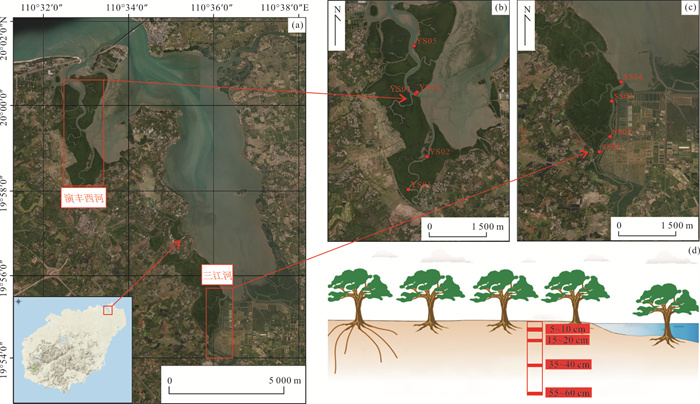
 下载:
下载:
